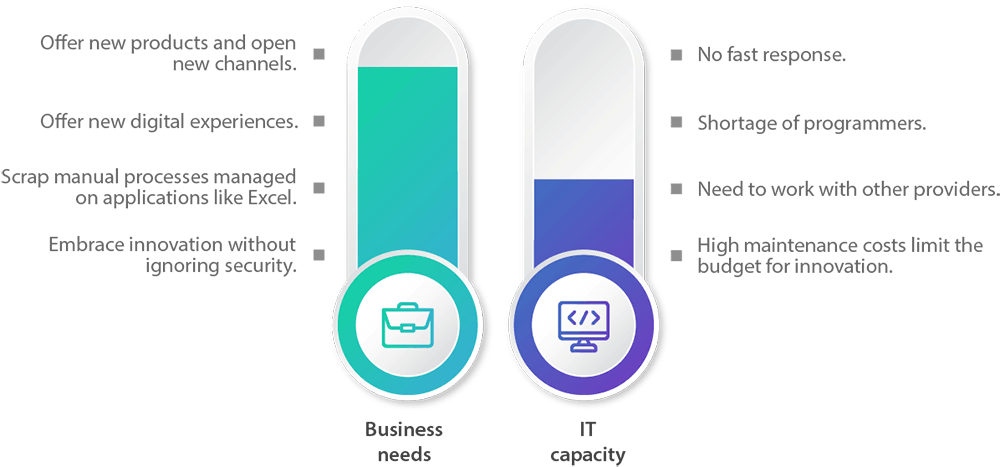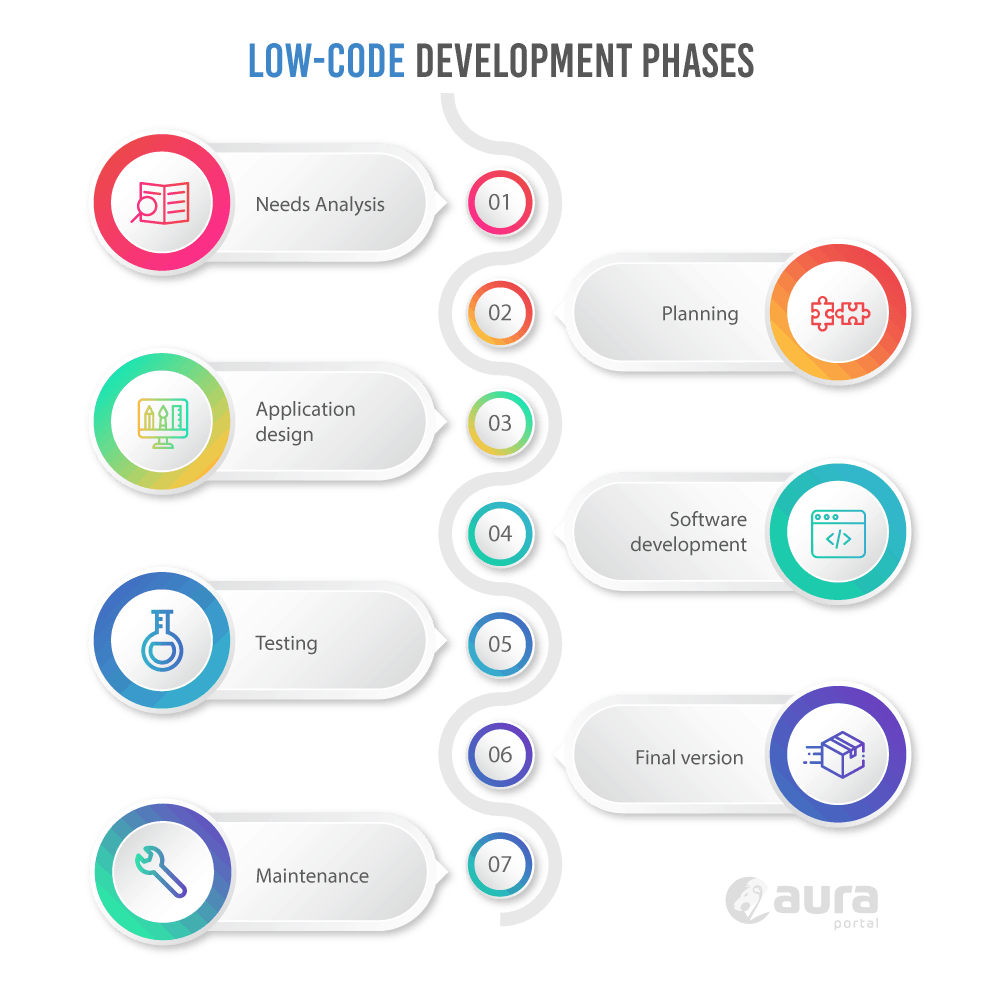Low code development phases
Blog: AuraQuantic Blog
In this article, ‘low code development phases’, we will explore the phases required for a successful development using a low-code platform and analyze some of the reasons why companies are increasingly opting for these technologies.
Today, IT departments do not have enough resources to deliver
all the software that organizations demand. In this context, organizations are
required to redefine their work model, and are relying on low-code
technologies.
It is important to review what we are doing now and
how we manage it, prior to initiating change. We have to make sure that the
culture of collaboration is established in our team, and if not, we must
encourage or even demand it.

PROGRAMMING METHODOLOGIES
Methodology refers to a plan established to meet certain objectives. If we stick to software development, we can list the following points as part of the plan:
- Define the activities to be carried out in a project
- Identify the information and resources we have
- Unify criteria
- Establish control points
- Ensure product quality
- Generate the appropriate documentation
- Maintenance
Currently, there are many programming methodologies, but the reality is that they all have common roots. And in all of them we will recognize shared features, although it is true that agile seems to fit more with low code because of its approach to fast deliveries (prototypes) and its focus on teamwork, and, ultimately, innovation.
In this article we will not go into detail about the characteristics of each of the methodologies, instead we will focus on the low code development phases.
LOW CODE DEVELOPMENT PHASES IN PRACTICE
All software development aims to respond to an organization’s needs and we must never lose sight of this objective. Focusing too much on the methodology can cause us to lose sight of the reason for starting the project in the first place.

Needs Analysis
The best way to start a project is to describe what is
needed and indicate what we would like to achieve. Obviously, the more detail
provided, the better the feedback.
Starting from this first review, we will perform a
deeper analysis to obtain the necessary requirements and application flows. At
this time, it is important to determine what business rules are required for
the desired functionality.
In addition, we will have to determine what data we
are going to work with and if we need to integrate with any other software
component. It is also time to address software security issues.
At this stage, it is necessary to arrange the necessary meetings with the end users. These informative and follow-up sessions will serve to align the application with the needs and expectations of the users.
Planning
Once the needs have been defined, we will begin the
planning phase of the project. This involves creating a work schedule to
specify the activities and execution times. In this phase, we will also define
partial deliveries and the meetings associated with them.
Logically, we will establish the teams that are going
to participate in the project and the role that they will assume.
Finally, a meeting with the team will be held to explain the project and the task assignments. Also, a session will be held for each specialist to contribute their ideas.
Application design
Once the requirements and the program flow have been specified, the design team will begin to work with the screens and forms. The purpose of this task is to make an initial presentation for users to give their opinions. If the meeting is satisfactory, we proceed to design the secondary flows and complementary screens.
Software development
At this stage the project requirements, scope and the
application flow are already defined, so the development team can begin its
work.
It is important that the planning and programming teams meet to define the deliverables that will be displayed to the user. This planning may be extended or reduced as necessary.
Testing
End users must validate and pass their recommendations on to the development team for each prototype received. In turn, the development team will perform technical tests to verify that the application works according to the established specifications. This cycle will be repeated for each prototype, including the final version, and it is always possible to go back.
Final version
Once the application’s functionalities have been
verified, it will be transferred to the production environment. Depending on
the complexity of the software, it may be interesting to plan courses to train
the solution’s end users.
The software should offer guiderails to help the user,
in addition to documented instructions.
Maintenance
During the application life cycle, it will be necessary to update it, add improvements and even develop new functionalities. In addition, it may be necessary to have technical support and solve incidents that may arise.
LOW CODE, THE AGILE IMPLEMENTATION METHODOLOGY
Low-code platforms are gaining importance in organizations because they optimize digital transformation projects. As we have seen in the section describing the phases of low-code development, the development process has been simplified and is focused on the end user.
In contrast, traditional development models are
showing their inefficiency by maintaining current work rates. The shortage of
resources and low participation from business users in the development phase does
not work in their favor.
But there are other factors, which we present below, that add a lot of value to low-code tools.
Innovation in the hands of the people
Technology must facilitate, not act as a barrier. Using traditional programming is an obstacle that prevents people with business knowledge from participating in the development.
It is necessary to simplify the creation process because once freed from complexity we can focus on innovation.
Applications in days
Low-code platforms allow applications to be generated using a visual interface and rely on pre-configured components for automations. These facilities help to minimize the number of errors and allow partial deliveries even in very early stages of development. In this way, the user can start contributing their opinions and ideas very soon and, therefore, the final software will be very adapted to their needs.
Empowering the user
It is very important for the application’s end users to actively participate in software development, sharing their business knowledge and detailing the necessary functionality to ensure that the final product is aligned with the business needs.
In short, low-code platforms are the definitive cog in the organizations’ drive to gain the level of agility and multidisciplinarity companies need to remain competitive.
The post Low code development phases appeared first on AuraPortal.
Leave a Comment
You must be logged in to post a comment.








